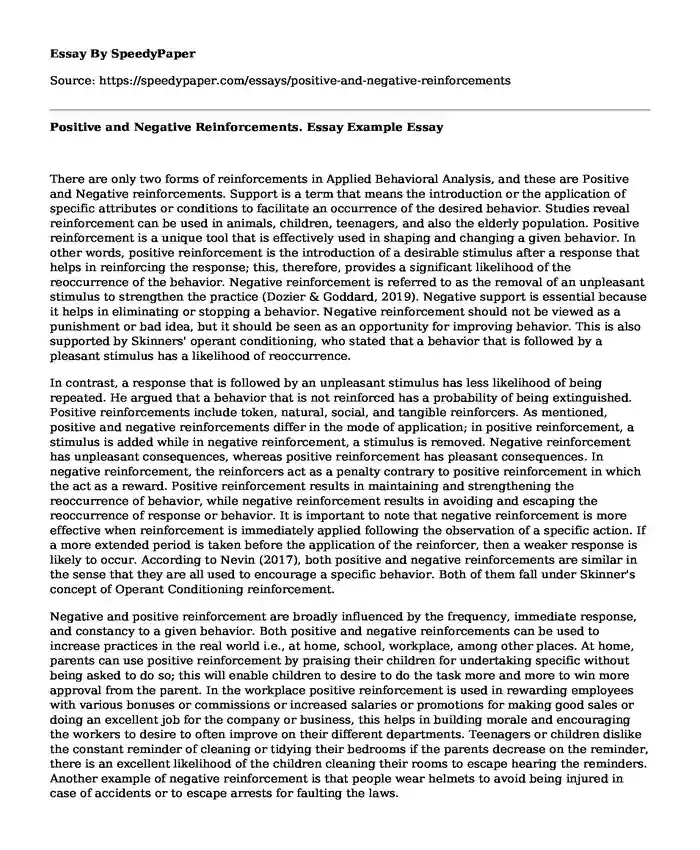
| Type of paper: | Essay |
| Categories: | Child development Social psychology Human behavior |
| Pages: | 3 |
| Wordcount: | 696 words |
There are only two forms of reinforcements in Applied Behavioral Analysis, and these are Positive and Negative reinforcements. Support is a term that means the introduction or the application of specific attributes or conditions to facilitate an occurrence of the desired behavior. Studies reveal reinforcement can be used in animals, children, teenagers, and also the elderly population. Positive reinforcement is a unique tool that is effectively used in shaping and changing a given behavior. In other words, positive reinforcement is the introduction of a desirable stimulus after a response that helps in reinforcing the response; this, therefore, provides a significant likelihood of the reoccurrence of the behavior. Negative reinforcement is referred to as the removal of an unpleasant stimulus to strengthen the practice (Dozier & Goddard, 2019). Negative support is essential because it helps in eliminating or stopping a behavior. Negative reinforcement should not be viewed as a punishment or bad idea, but it should be seen as an opportunity for improving behavior. This is also supported by Skinners' operant conditioning, who stated that a behavior that is followed by a pleasant stimulus has a likelihood of reoccurrence.
In contrast, a response that is followed by an unpleasant stimulus has less likelihood of being repeated. He argued that a behavior that is not reinforced has a probability of being extinguished. Positive reinforcements include token, natural, social, and tangible reinforcers. As mentioned, positive and negative reinforcements differ in the mode of application; in positive reinforcement, a stimulus is added while in negative reinforcement, a stimulus is removed. Negative reinforcement has unpleasant consequences, whereas positive reinforcement has pleasant consequences. In negative reinforcement, the reinforcers act as a penalty contrary to positive reinforcement in which the act as a reward. Positive reinforcement results in maintaining and strengthening the reoccurrence of behavior, while negative reinforcement results in avoiding and escaping the reoccurrence of response or behavior. It is important to note that negative reinforcement is more effective when reinforcement is immediately applied following the observation of a specific action. If a more extended period is taken before the application of the reinforcer, then a weaker response is likely to occur. According to Nevin (2017), both positive and negative reinforcements are similar in the sense that they are all used to encourage a specific behavior. Both of them fall under Skinner's concept of Operant Conditioning reinforcement.
Negative and positive reinforcement are broadly influenced by the frequency, immediate response, and constancy to a given behavior. Both positive and negative reinforcements can be used to increase practices in the real world i.e., at home, school, workplace, among other places. At home, parents can use positive reinforcement by praising their children for undertaking specific without being asked to do so; this will enable children to desire to do the task more and more to win more approval from the parent. In the workplace positive reinforcement is used in rewarding employees with various bonuses or commissions or increased salaries or promotions for making good sales or doing an excellent job for the company or business, this helps in building morale and encouraging the workers to desire to often improve on their different departments. Teenagers or children dislike the constant reminder of cleaning or tidying their bedrooms if the parents decrease on the reminder, there is an excellent likelihood of the children cleaning their rooms to escape hearing the reminders. Another example of negative reinforcement is that people wear helmets to avoid being injured in case of accidents or to escape arrests for faulting the laws.
Conclusion
Reinforcement is essential in encouraging a particular behavior. Positive reinforcement entails the presentation of a favorable enforcer while negative reinforcement involves the removal of the unpleasant reinforcer. Reinforcement is essential in our daily life, as discussed in the various examples in the discussion. It is important to note that frequency and schedule play a significant role in strengthening the response to a given reinforcement.
References
Dozier, C. L., Foley, E. A., Goddard, K. S., & Jess, R. L. (2019). Reinforcement. The Encyclopedia of Child and Adolescent Development, 1-10.
Nevin, J. A., & Mandell, C. (2017). Comparing positive and negative reinforcement: A fantasy experiment. Journal of the experimental analysis of behavior, 107(1), 34-38.
Cite this page
Positive and Negative Reinforcements. Essay Example. (2023, Aug 01). Retrieved from https://speedypaper.net/essays/positive-and-negative-reinforcements
Request Removal
If you are the original author of this essay and no longer wish to have it published on the SpeedyPaper website, please click below to request its removal:
- Role of the Media in Portraying People in Realistic Ways - Essay Sample
- Essay Sample Dedicated to Nursing Career Advancement
- Fear and Human Behavior - The Modern Day Witch Hunt
- Free Essay Describing the Importance of Preschool
- Essay Example on How Traumatic Experiences Impact Academic Performance
- Free Essay on Child Development: The Beast of Social Media
- Free Essay Example. Marriage and Parenting in Adulthood
Popular categories




